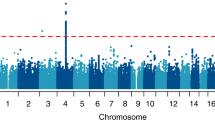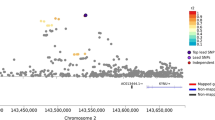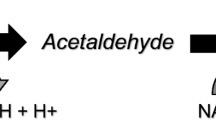Abstract
On the basis of the converging evidence showing regulation of drinking behavior by 5-HT3AB receptors and the serotonin transporter, we hypothesized that the interactive effects of genetic variations in the genes HTR3A, HTR3B, and SLC6A4 confer greater susceptibility to alcohol dependence (AD) than do their effects individually. We examined the associations of AD with 22 SNPs across HTR3A, HTR3B, and two functional variants in SLC6A4 in 500 AD and 280 healthy control individuals of European descent. We found that the alleles of the low-frequency SNPs rs33940208:T in HTR3A and rs2276305:A in HTR3B were inversely and nominally significantly associated with AD with odds ratio (OR) and 95 % confidence interval of 0.212 and 0.073, 0.616 (P = 0.004) and 0.261 and 0.088, 0.777 (P = 0.016), respectively. Further, our gene-by-gene interaction analysis revealed that two four-variant models that differed by only one SNP carried a risk for AD (empirical P < 1 × 10−6 for prediction accuracy of the two models based on 106 permutations). Subsequent analysis of these two interaction models revealed an OR of 2.71 and 2.80, respectively, for AD (P < 0.001) in carriers of genotype combinations 5′-HTTLPR:LL/LS(SLC6A4)–rs1042173:TT/TG(SLC6A4)–rs1176744:AC(HTR3B)–rs3782025:AG(HTR3B) and 5′-HTTLPR:LL/LS(SLC6A4)–rs10160548:GT/TT(HTR3A)–rs1176744:AC(HTR3B)–rs3782025:AG(HTR3B). Combining all five genotypes resulted in an OR of 3.095 (P = 2.0 × 10−4) for AD. Inspired by these findings, we conducted the analysis in an independent sample, OZ-ALC-GWAS (N = 6699), obtained from the NIH dbGAP database, which confirmed the findings, not only for all three risk genotype combinations (Z = 4.384, P = 1.0 × 10−5; Z = 3.155, P = 1.6 × 10−3; and Z = 3.389, P = 7.0 × 10−4, respectively), but also protective effects for rs33940208:T (χ 2 = 3.316, P = 0.0686) and rs2276305:A (χ 2 = 7.224, P = 0.007). These findings reveal significant interactive effects among variants in SLC6A4–HTR3A–HTR3B affecting AD. Further studies are needed to confirm these findings and characterize the molecular mechanisms underlying these effects.

Similar content being viewed by others
References
American Psychiatric Association (1994) Diagnostic and statistical manual of mental disorders, 4th edn. American Psychiatric Association, Washington, DC
Barrett JC, Fry B, Maller J, Daly MJ (2005) Haploview: analysis and visualization of LD and haplotype maps. Bioinformatics 21:263–265
Bohn MJ, Babor TF, Kranzler HR (1995) The Alcohol Use Disorders Identification Test (AUDIT): validation of a screening instrument for use in medical settings. J Stud Alcohol 56:423–432
Davies PA, Pistis M, Hanna MC, Peters JA, Lambert JJ, Hales TG, Kirkness EF (1999) The 5-HT3B subunit is a major determinant of serotonin-receptor function. Nature 397:359–363. doi:10.1038/16941
Ducci F, Enoch MA, Yuan Q, Shen PH, White KV, Hodgkinson C, Albaugh B, Virkkunen M, Goldman D (2009) HTR3B is associated with alcoholism with antisocial behavior and alpha EEG power—an intermediate phenotype for alcoholism and co-morbid behaviors. Alcohol 43:73–84. doi:10.1016/j.alcohol.2008.09.005
Enoch MA, Gorodetsky E, Hodgkinson C, Roy A, Goldman D (2011) Functional genetic variants that increase synaptic serotonin and 5-HT3 receptor sensitivity predict alcohol and drug dependence. Mol Psychiatry 16:1139–1146. doi:10.1038/mp.2010.94
First MB, Spitzer RL, Gibbon M, Williams JBW (1994) Structured Clinical Interview for DSM-IV Axis I Disorders, New York
Frank B, Niesler B, Nothen MM, Neidt H, Propping P, Bondy B, Rietschel M, Maier W, Albus M, Rappold G (2004) Investigation of the human serotonin receptor gene HTR3B in bipolar affective and schizophrenic patients. Am J Med Genet B Neuropsychiatr Genet 131B:1–5. doi:10.1002/ajmg.b.30070
Goldstein DB (2009) Common genetic variation and human traits. N Engl J Med 360:1696–1698. doi:10.1056/NEJMp0806284
Hammer C, Kapeller J, Endele M, Fischer C, Hebebrand J, Hinney A, Friedel S, Gratacos M, Estivill X, Fichter M, Fernandez-Aranda F, Ehrlich S, Rappold G, Niesler B (2009) Functional variants of the serotonin receptor type 3A and B gene are associated with eating disorders. Pharmacogenet Genomics 19:790–799. doi:10.1097/FPC.0b013e32833132b3
Hammer C, Cichon S, Muhleisen TW, Haenisch B, Degenhardt F, Mattheisen M, Breuer R, Witt SH, Strohmaier J, Oruc L, Rivas F, Babadjanova G, Grigoroiu-Serbanescu M, Hauser J, Roth R, Rappold G, Rietschel M, Nothen MM, Niesler B (2012) Replication of functional serotonin receptor type 3A and B variants in bipolar affective disorder: a European multicenter study. Transl Psychiatry 2:e103. doi:10.1038/tp.2012.30
Hayes DJ, Greenshaw AJ (2011) 5-HT receptors and reward-related behaviour: a review. Neurosci Biobehav Rev 35:1419–1449. doi:10.1016/j.neubiorev.2011.03.005
Hodge CW, Kelley SP, Bratt AM, Iller K, Schroeder JP, Besheer J (2004) 5-HT(3A) receptor subunit is required for 5-HT3 antagonist-induced reductions in alcohol drinking. Neuropsychopharmacology 29:1807–1813. doi:10.1038/sj.npp.1300498
Howie BN, Donnelly P, Marchini J (2009) A flexible and accurate genotype imputation method for the next generation of genome-wide association studies. PLoS Genet 5:e1000529. doi:10.1371/journal.pgen.1000529
Iidaka T, Ozaki N, Matsumoto A, Nogawa J, Kinoshita Y, Suzuki T, Iwata N, Yamamoto Y, Okada T, Sadato N (2005) A variant C178T in the regulatory region of the serotonin receptor gene HTR3A modulates neural activation in the human amygdala. J Neurosci 25:6460–6466. doi:10.1523/JNEUROSCI.5261-04.2005
Johnson BA (2000) Serotonergic agents and alcoholism treatment: rebirth of the subtype concept—an hypothesis. Alcohol Clin Exp Res 24:1597–1601
Johnson BA, Javors MA, Roache JD, Seneviratne C, Bergeson SE, Ait-Daoud N, Dawes MA, Ma JZ (2008) Can serotonin transporter genotype predict serotonergic function, chronicity, and severity of drinking? Prog Neuropsychopharmacol Biol Psychiatry 32:209–216. doi:10.1016/j.pnpbp.2007.07.030
Johnson BA, Ait-Daoud N, Seneviratne C, Roache JD, Javors MA, Wang XQ, Liu L, Penberthy JK, DiClemente CC, Li MD (2011) Pharmacogenetic approach at the serotonin transporter gene as a method of reducing the severity of alcohol drinking. Am J Psychiatry 168:265–275. doi:10.1176/appi.ajp.2010.10050755
Kapeller J, Houghton LA, Monnikes H, Walstab J, Moller D, Bonisch H, Burwinkel B, Autschbach F, Funke B, Lasitschka F, Gassler N, Fischer C, Whorwell PJ, Atkinson W, Fell C, Buchner KJ, Schmidtmann M, van der Voort I, Wisser AS, Berg T, Rappold G, Niesler B (2008) First evidence for an association of a functional variant in the microRNA-510 target site of the serotonin receptor-type 3E gene with diarrhea predominant irritable bowel syndrome. Hum Mol Genet 17:2967–2977. doi:10.1093/hmg/ddn195
Kilpatrick LA, Labus JS, Coveleskie K, Hammer C, Rappold G, Tillisch K, Bueller JA, Suyenobu B, Jarcho JM, McRoberts JA, Niesler B, Mayer EA (2011) The HTR3A polymorphism c. −42C>T is associated with amygdala responsiveness in patients with irritable bowel syndrome. Gastroenterology 140:1943–1951. doi:10.1053/j.gastro.2011.03.011
Knopik VS, Heath AC, Madden PA, Bucholz KK, Slutske WS, Nelson EC, Statham D, Whitfield JB, Martin NG (2004) Genetic effects on alcohol dependence risk: re-evaluating the importance of psychiatric and other heritable risk factors. Psychol Med 34:1519–1530
Krzywkowski K, Davies PA, Feinberg-Zadek PL, Brauner-Osborne H, Jensen AA (2008) High-frequency HTR3B variant associated with major depression dramatically augments the signaling of the human 5-HT3AB receptor. Proc Natl Acad Sci USA 105:722–727. doi:10.1073/pnas.0708454105
Laird NM, Horvath S, Xu X (2000) Implementing a unified approach to family-based tests of association. Genet Epidemiol 19 Suppl 1: S36-42. doi:10.1002/1098-2272(2000)19:1+<::AID-GEPI6>3.0.CO;2-M
Li MD, Beuten J, Ma JZ, Payne TJ, Lou XY, Garcia V, Duenes AS, Crews KM, Elston RC (2005) Ethnic- and gender-specific association of the nicotinic acetylcholine receptor alpha4 subunit gene (CHRNA4) with nicotine dependence. Hum Mol Genet 14:1211–1219
Lim JE, Papp A, Pinsonneault J, Sadee W, Saffen D (2006) Allelic expression of serotonin transporter (SERT) mRNA in human pons: lack of correlation with the polymorphism SERTLPR. Mol Psychiatry 11:649–662. doi:10.1038/sj.mp.4001797
Liu DJ, Leal SM (2012) Estimating genetic effects and quantifying missing heritability explained by identified rare-variant associations. Am J Hum Genet 91:585–596. doi:10.1016/j.ajhg.2012.08.008
Lochner M, Lummis SC (2010) Agonists and antagonists bind to an A–A interface in the heteromeric 5-HT3AB receptor. Biophys J 98:1494–1502. doi:10.1016/j.bpj.2009.12.4313
Lou XY, Chen GB, Yan L, Ma JZ, Zhu J, Elston RC, Li MD (2007) A generalized combinatorial approach for detecting gene-by-gene and gene-by-environment interactions with application to nicotine dependence. Am J Hum Genet 80:1125–1137
Lovinger DM (1997) Serotonin’s role in alcohol’s effects on the brain. Alcohol Health Res World 21:114–120
Lynskey MT, Nelson EC, Neuman RJ, Bucholz KK, Madden PA, Knopik VS, Slutske W, Whitfield JB, Martin NG, Heath AC (2005) Limitations of DSM-IV operationalizations of alcohol abuse and dependence in a sample of Australian twins. Twin Res Hum Genet 8:574–584. doi:10.1375/183242705774860178
Mao X, Bigham AW, Mei R, Gutierrez G, Weiss KM, Brutsaert TD, Leon-Velarde F, Moore LG, Vargas E, McKeigue PM, Shriver MD, Parra EJ (2007) A genomewide admixture mapping panel for Hispanic/Latino populations. Am J Hum Genet 80:1171–1178. doi:10.1086/518564
Massoura AN, Dover TJ, Newman AS, Barnes NM (2011) The identification of N-glycosylated residues of the human 5-HT3B receptor subunit: importance for cell membrane expression. J Neurochem 116:975–983. doi:10.1111/j.1471-4159.2010.07129.x
Miyake A, Mochizuki S, Takemoto Y, Akuzawa S (1995) Molecular cloning of human 5-hydroxytryptamine3 receptor: heterogeneity in distribution and function among species. Mol Pharmacol 48:407–416
Narahashi T, Kuriyama K, Illes P, Wirkner K, Fischer W, Muhlberg K, Scheibler P, Allgaier C, Minami K, Lovinger D, Lallemand F, Ward RJ, DeWitte P, Itatsu T, Takei Y, Oide H, Hirose M, Wang XE, Watanabe S, Tateyama M, Ochi R, Sato N (2001) Neuroreceptors and ion channels as targets of alcohol. Alcohol Clin Exp Res 25:182S–188S
Nyholt DR (2004) A simple correction for multiple testing for single-nucleotide polymorphisms in linkage disequilibrium with each other. Am J Hum Genet 74:765–769
Purcell S, Neale B, Todd-Brown K, Thomas L, Ferreira MA, Bender D, Maller J, Sklar P, de Bakker PI, Daly MJ, Sham PC (2007) PLINK: a tool set for whole-genome association and population-based linkage analyses. Am J Hum Genet 81:559–575. doi:10.1086/519795
Raychaudhuri S (2011) Mapping rare and common causal alleles for complex human diseases. Cell 147:57–69. doi:10.1016/j.cell.2011.09.011
Seneviratne C, Ait-Daoud N, Ma JZ, Chen G, Johnson BA, Li MD (2009a) Susceptibility locus in neurokinin-1 receptor gene associated with alcohol dependence. Neuropsychopharmacology 34:2442–2449. doi:10.1038/npp.2009.65
Seneviratne C, Huang W, Ait-Daoud N, Li MD, Johnson BA (2009b) Characterization of a functional polymorphism in the 3′ UTR of SLC6A4 and its association with drinking intensity. Alcohol Clin Exp Res 33:332–339. doi:10.1111/j.1530-0277.2008.00837.x
Sugita S, Shen KZ, North RA (1992) 5-Hydroxytryptamine is a fast excitatory transmitter at 5-HT3 receptors in rat amygdala. Neuron 8:199–203
Sun D, Ma JZ, Payne TJ, Li MD (2008) Beta-arrestins 1 and 2 are associated with nicotine dependence in European American smokers. Mol Psychiatry 13:398–406. doi:10.1038/sj.mp.4002036
Sung KW, Engel SR, Allan AM, Lovinger DM (2000) 5-HT(3) receptor function and potentiation by alcohols in frontal cortex neurons from transgenic mice overexpressing the receptor. Neuropharmacology 39:2346–2351 (pii:S0028390800000642)
Vinkhuyzen AA, Dumenil T, Ryan L, Gordon SD, Henders AK, Madden PA, Heath AC, Montgomery GW, Martin NG, Wray NR (2011) Identification of tag haplotypes for 5HTTLPR for different genome-wide SNP platforms. Mol Psychiatry 16:1073–1075. doi:10.1038/mp.2011.68
Walstab J, Hammer C, Bonisch H, Rappold G, Niesler B (2008) Naturally occurring variants in the HTR3B gene significantly alter properties of human heteromeric 5-hydroxytryptamine-3A/B receptors. Pharmacogenet Genomics 18:793–802. doi:10.1097/FPC.0b013e3283050117
Yamada K, Hattori E, Iwayama Y, Ohnishi T, Ohba H, Toyota T, Takao H, Minabe Y, Nakatani N, Higuchi T, Detera-Wadleigh SD, Yoshikawa T (2006) Distinguishable haplotype blocks in the HTR3A and HTR3B region in the Japanese reveal evidence of association of HTR3B with female major depression. Biol Psychiatry 60:192–201. doi:10.1016/j.biopsych.2005.11.008
Yang Z, Seneviratne C, Wang S, Ma JZ, Payne TJ, Wang J, Li MD (2013) Serotonin transporter and receptor genes significantly impact nicotine dependence through genetic interactions in both European American and African American smokers. Drug Alcohol Depend 129:217–225. doi:10.1016/j.drugalcdep.2012.12.007
Zhou Q, Verdoorn TA, Lovinger DM (1998) Alcohols potentiate the function of 5-HT3 receptor-channels on NCB-20 neuroblastoma cells by favouring and stabilizing the open channel state. J Physiol 507(Pt 2):335–352
Zhu Y, Xiong M (2012) Family-based association studies for next-generation sequencing. Am J Hum Genet 90:1028–1045. doi:10.1016/j.ajhg.2012.04.022
Acknowledgments
This study was funded by grants from the National Institute on Drug Abuse to MDL (Grants R01 DA012844 and 5 R01DA013783) and from the National Institute on Alcohol Abuse and Alcoholism to BAJ (Grants 7 U10 AA011776-10, 1 N01 AA001016-000, 7 R01 AA010522-12, and 5 R01 AA012964-06) and NA-D (Grant 5 K23 AA000329-06). We are grateful to Dr. Shaolin Wang for his help with the statistical analyses. Additionally, we are thankful to the NIH GWAS data repository for providing us access to their dataset, through project 771 to Ming D. Li, under the title of “Genome-wide association analysis for addiction and type 2 diabetes”. GWAS of Alcohol Research using Australian twins and their families (OZ-ALC): Funding support for the [CIDR-OZ-ALC GWAS] was provided through the [Center for Inherited Disease Research (CIDR)] and the National Institute on Alcohol Abuse and Alcoholism (NIAAA). [CIDR-OZ-ALC GWAS] is a genome-wide association study funded as part of NIAAA grant 5 R01 AA013320-04. Assistance with phenotype harmonization and genotype cleaning, as well as with general study coordination, was provided by the [CIDR-OZ-ALC GWAS]. Assistance with data cleaning was provided by the National Center for Biotechnology Information. Support for collection of datasets and samples was provided by the MARC: Risk Mechanisms in Alcoholism and Comorbidity (MARC; P60 AA011998-11). Funding support for genotyping, which was performed at the Johns Hopkins University Center for Inherited Disease Research, was provided by the NIH GEI (U01HG004438), the NIAAA, and the NIH contract “High throughput genotyping for studying the genetic contributions to human disease” (HHSN268200782096C).
Author information
Authors and Affiliations
Corresponding author
Electronic supplementary material
Below is the link to the electronic supplementary material.
Rights and permissions
About this article
Cite this article
Seneviratne, C., Franklin, J., Beckett, K. et al. Association, interaction, and replication analysis of genes encoding serotonin transporter and 5-HT3 receptor subunits A and B in alcohol dependence. Hum Genet 132, 1165–1176 (2013). https://doi.org/10.1007/s00439-013-1319-y
Received:
Accepted:
Published:
Issue Date:
DOI: https://doi.org/10.1007/s00439-013-1319-y




